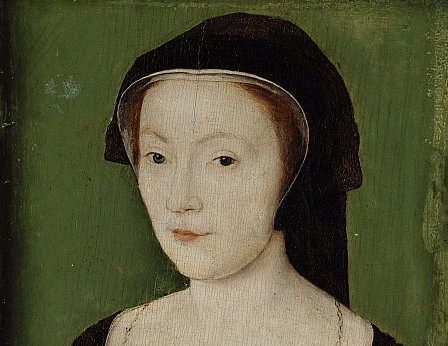Together with Tudor Times we bring you a profile on a different Tudor figure every month. This month it’s the turn of the wife of King James V of Scotland…

Railed against by John Knox, in his First Blast of the Trumpet against the Monstrous Regiment of Women, Marie of Guise (1515-1560), wife of King James V of Scotland, proved that a woman could be as effective as a man at wielding power, and not necessarily any more scrupulous.
A French cadet branch of the sovereign House of Lorraine, the Guises, Marie included, worked tirelessly to enhance the family’s power across Europe. Marie was plucked out of the cloister she had been destined for, when her uncle, Antoine, Duke of Lorraine, realised that her charm and good looks, allied to her noble blood, would make her a very enticing marriage prospect – perhaps even for royalty.
Marie first appeared at the French court at the coronation of Eleanora of Austria, second wife of King Francois I. Dressed like the royal princesses in purple velvet, with a mantle of ermines studded with precious jewels, she followed the new Queen on her entry into Paris.
In 1534, Marie’s marriage was arranged to Louis, Duke of Longueville. After three years of happy wedlock, Louis died, leaving Marie pregnant and with a young son. Before the year was out, she had been married again, to the widowed King of Scots, much to the chagrin of his uncle, King Henry VIII, who had considered Marie as a possible fourth wife.
Marie arrived in Scotland in June 1538, and was crowned in February 1540 at Holyrood Abbey. Her tenure as Queen Consort was short – James V died in 1542, a mere week after Marie had given birth to Mary, who was now Queen of Scots.
Marie was not appointed as Regent, and spent the next few years manoeuvring between the Scots nobles, some of whom favoured alliance with England, whilst others wished to preserve the Franco-Scottish “Auld Alliance”. Marie, unsurprisingly, was totally committed to France. Her ambitions were fulfilled by the 1548 Treaty of Haddington which promised Mary, Queen of Scots, to the Dauphin of France, and made Scotland, in effect, a French protectorate. The human cost of the treaty was Marie’s agreement to send her five-year-old daughter to France.
Eventually, in 1554, Marie was installed as Regent. Until 1558, matters went well. Marie was an effective ruler, popular with the people and on good terms with the majority of the Scots nobles. However, the growing Protestant movement created difficulties. Marie, although Catholic herself, was willing to grant some religious freedom, but that did not satisfy the leaders of the increasingly vocal Protestants, led by the eloquent John Knox. Religious riots culminated in open rebellion, which Marie attempted to quell using French troops. The Protestants appealed for help to England, and ships were sent to support them. In the midst of the turmoil, Marie died.
Visit Tudor Times for more on the incredible life of Marie of Guise.
Related articles10 things you didn’t know about the Tudors |
Click here to subscribe! |






 © 2024
© 2024